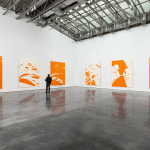“Renaissance Siena: Art for a City,” National Gallery, London. Through Jan. 13.
A hundred paintings, sculptures, drawings, manuscripts and ceramics are presented. Artists include Matteo di Giovanni, Francesco di Giorgio, Benvenuto di Giovanni, the Master of the Legend of Griselda, Signorelli, Pintoricchio and Beccafumi. In The Guardian, Jonathan Jones suggests that the curators are chasing their tails down a scholarly blind alley. “The National Gallery has developed dangerous signs of failing to edit its curators’ ideas. Instead of looking hard at the shortlist of possible exhibitions, it leaps on ‘interesting’ notions that, in reality, are eccentric hobby-horses. Some of its recent and planned exhibitions – notably Renoir Landscapes and the retrospective of a minor 18th-century portraitist, Pompeo Batoni, to which we can look forward in the New Year – are the National Gallery’s answer to Spinal Tap convincing themselves that now no one cares what they do, they can finally dust off that free-form jazz odyssey….We’re seriously supposed to admire a painting such as Sano di Pietro’s Virgin and Child With Saints Jerome and Bernardino and Four Angels, painted in about 1455-60, the product of a workshop that churned out this type of image? The catalogue enthuses that it’s like ‘a piece of goldsmith’s work, and its superb condition ensures that its craftsmanship is undimmed’. But to me, with its smooth, not to say bland, rendition of soapy-looking flesh, its cheap gold glitz, its all but expressionless faces, it resembles nothing so much as an icon you might buy from a sacred souvenir shop in the Vatican today. It bears about the same relationship as such a pastiche would to the great medieval religious art of Duccio: that is to say, none of any interest.” Read more.
In the Evening Standard, Brian Sewell tends to agree. “Many of these Sienese painters were either consciously archaic, deliberately echoing the painters of the brief period more than a century before, when their city was indeed in the grip of a Renaissance, or, with such echoes, they were satisfying the demands of their patrons to bridge the great gap between the then present and the noble past by constantly referring to it. Florentine influences are occasionally evident – hard-worked perspective in one painting, a hint of naked bodies akin to those of Pollaiuolo in another, the sinister whisper of Leonardo in a third – but the gap in years is always telling, as though news of Fra Angelico and Domenico Veneziano had not, in as many years, travelled the 30 miles from Florence. Donatello, the greatest sculptor of the century, travelled those miles himself to make a handful of small masterpieces, but the fervour and invention that he carried in his baggage might as well have been stale varieties of pasta for all the influence he had – the great commission for the cathedral doors was quietly aborted.” Read more.






















